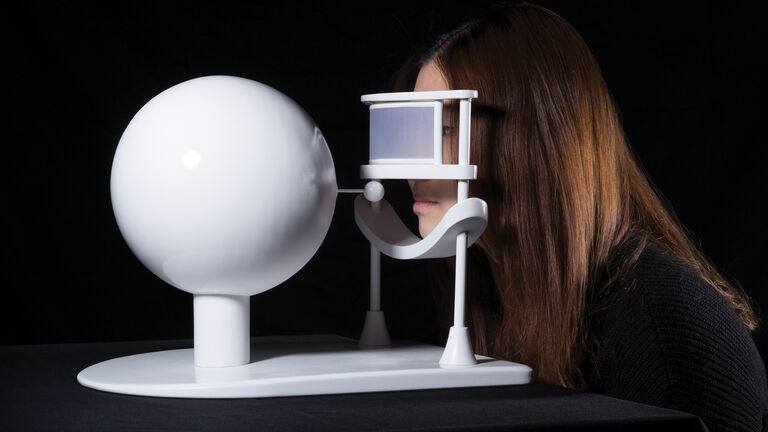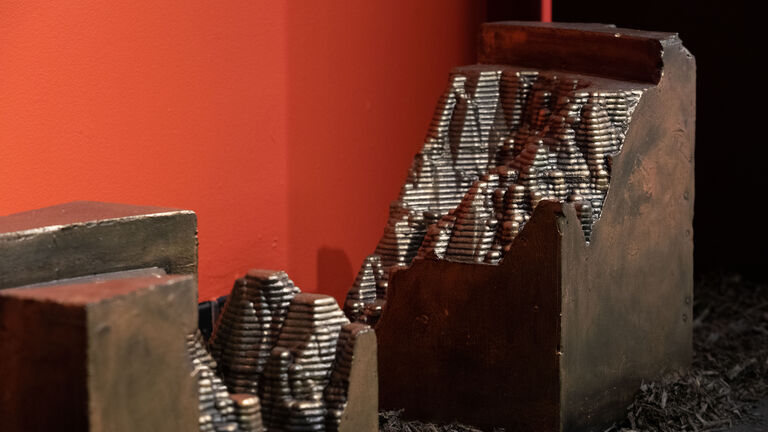
"Reality reset" by Stella Shen
Master of Design in Designed Objects Admissions Information
Master of Design in Designed Objects
The Master of Design in Designed Objects (MDDO) is a professional degree program with a structured curriculum that offers students the critical skills to imagine and create meaningful design objects, systems, and experiences while challenging the boundaries of the field of design itself.
Redefining Object Design
Designers reimagine the objects and systems that mediate our daily lives. Through a critical appraisal of product, furniture, interaction, and systems design, the MDDO program teaches designers to be agents of change who maintain an expansive understanding of the object. Future designers need to be enlightened practitioners, willing to explore unknown territory and work with problems not yet defined. The program encourages students to challenge the fluid borderline that outlines design, opening the field to unexpected possibilities. MDDO students are encouraged to develop their practice by taking elective courses in other departments across SAIC and by applying to AIADO’s External Partnership Courses.
Alumni of the MDDO program have attained success and professional experience in a diverse range of careers from product and furniture design, user experience design, creative direction, design research and strategy, design education and independent design practice.
Master of Design in Designed Objects Curriculum
The Master of Design in Designed Objects (MDDO) is a two-year, 66 credit hour program with a carefully sequenced course-based curriculum, built for students who seek immersion in the critical and technical skills specific to the extended practice of object design.
-
MDDO Degree Requirements and Specifications
- Completion schedule: Students have a maximum of four years to complete the master of design degree program. This includes time off for leaves of absence.
- Transfer credit: Generally transfer credits are not accepted. All requests for transfer credits are reviewed individually by the chair of the department at the time of admission and are subject to approval at that time. No transfer credit will be permitted after a student is admitted.
- Full-Time Status Minimum Requirement: 12 credit hours
Term Credit Hours First Summer Intensive 6 - DESOB 5050 Refresh: Summer Intensive (6)
First Year Fall 15 - DESOB 5150 Studio 1: Reset (3)
- DESOB 5152 Research Methods Lab (3)
- DESOB 5164 Material Intelligence Studio Seminar (3)
- ARTHI 5120 Survey of Modern and Contemporary Arch. and design (3)
- Elective (3)
First Year Spring 15 - DESOB 5160 Studio 2: Discover (6)
- DESOB 5162 Prototyping Methods Lab (3)
- ARTHI 6120 Critical Issues in Designed Objects (3)
- Elective (3)
Second Year Fall15 - DESOB 6150 Thesis Studio 1: Initiate (6)
- DESOB 6152 Material Futures Studio Seminar (3)
- Art History Elective (3)
- Elective or Internship (3)
Second Year Spring15 - DESOB 6160 Thesis Studio 2: Manifest (6)
- DESOB 6162 Positioning Methods Lab (3)
- Elective (3)
- Elective (3)
Participation in four Graduate Critiques
Participation in Graduate Design Exhibition
Total Credit Hours66
MDDO Versus MFA
In contrast to the structured curriculum of the MDDO, the two-year Master of Fine Arts (MFA) in Studio, Designed Objects is for students looking for a self-directed program of independent study. Students work with faculty advisors on a one to one basis each semester to pursue a range of design projects that reflect their specific interests. Applicants are expected to have previous experience and a strong portfolio in three-dimensional design practice, and the ability to self-manage an extended program of independent study.
Courses
Master of Design in Designed Objects Application and Admissions Information
-
Priority Deadline: December 1 - $45 Application Fee
Application Deadline: January 10 - $90 Application Fee
Apply online via SlideRoomSAIC requires applicants to apply online. Filing an online application requires a valid credit card and a current email address. You may apply to up to three programs with one application and fee. If you are applying to either the MFA in Studio or the Post-Baccalaureate Certificate in Studio you may select up to three departments of entry.
Applications must be submitted prior to 11:00 p.m. (CT) on the appropriate deadline. When you click the "submit" button on the Graduate Application form, you will be prompted to enter credit card information to pay the application fee. Your application form is not fully submitted until you have entered your credit card information.
Under no circumstances will an application fee be refunded. After you submit the application form you will be directed to a dashboard where you can begin working on your ePortfolio(s).
-
A conferred four-year baccalaureate degree or its equivalent is required for admission to all graduate programs at SAIC. Transcripts are records of your studies that list the courses you completed, the grades received, and provide evidence of degree conferral. They may include grade sheets, exam results, final diplomas, degrees, or graduation certificates. Official copies are issued in the original language directly by your university. Copies must bear the official stamp or seal of the institution, as well as the signature of the appropriate official such as the dean, rector, registrar, controller of examinations, or office of teaching affairs. Photos, notarized copies, facsimiles, or email transmissions are not acceptable.
Official translations are expected for all educational documents issued in a language other than English. A translation agency or university language department should issue official translations typed on official stationery and the translator must attest proficiency in the original language and indicate their translations are accurate word-for-word.
During the application process an unofficial transcript is acceptable for review pending an Admissions decision. Official transcripts are required upon admission. Include transcripts both official and unofficial from all universities/colleges from which a degree was obtained or prerequisites were fulfilled. You can attach unofficial transcripts as .pdf or .jpg files in the Educational History section of the application form. If you are in the process of completing a bachelor's degree when you apply, a transcript showing your first three years of study is acceptable.
Transcripts are considered official if sent directly from the degree- or credit-granting institution to the SAIC Graduate Admissions Office. Hard copy transcripts are considered official if the documents remain in the registrar's original signed and sealed envelopes. Official transcripts can be sent both in digital and hard-copy format. Digital transcripts can be sent from the degree- or credit-granting institution to gradmiss@saic.edu. Hard copy transcripts can be mailed to:
SAIC Graduate Admissions
36 S. Wabash Ave., Suite 1201
Chicago, IL 60603Students admitted to a graduate program who have not received a high school diploma, GED or equivalent are not eligible for federal Title IV financial aid funds.
-
Write a 500–700 word statement of purpose describing the history of your interests and experiences in design, your personal and professional motivation and goals, and your reasons for pursuing graduate study in design at SAIC. Save your statement of purpose as a PDF and upload it as an attachment.
A statement of intent is required for all graduate programs though the content varies by department. You will upload your statement of purpose to the Attachments section of your E-Portfolio.
-
2 letters of reference are required.
You are responsible for securing letters of recommendation from persons who are qualified to write about your potential for success at SAIC. If you are currently a student or are a recent graduate, we recommend you request letters of recommendation from current or former instructors.
Letters of recommendation should be submitted electronically via the References section of the application form. In this section you will be asked to provide an email address for each of your references. Once you click "send request," an email will be sent from SlideRoom to your references with instructions on how to submit their recommendations online.
If your references are unable to provide an online recommendation please contact the Graduate Admissions office at gradmiss@saic.edu.
-
A current résumé is required.
A resume is required for all graduate programs. Upload your résumé to the Attachments section in your E-Portfolio.
-
Your portfolio should include a minimum of five different projects documented in up to 20 images, or up to 10 minutes of time-based work, or a combination of the two in which one image is equivalent to approximately 30 seconds of time-based work.
Applicants are required to submit an E-Portfolio, though the content varies by department. Please visit your individual program of interest to find details. You must submit a separate E-Portfolio for each program or studio department to which you apply. After you pay the application fee and submit the application form, an E-Portfolio for each of the programs you selected in the application form will automatically appear in your SlideRoom dashboard.
Submission Specifications:
- Images: .jpg, .gif, .pdf (up to 5 MB each)
- Videos: .flv, .wv, .mov (up to 60 MB each)
- Audio: .mp3 (up to 10 MB each)
- Text documents: MUST be in .pdf format (up to 10 MB each)
-
TOEFL: 100
IELTS: 7
DUOLINGO: 120International applicants are required to submit evidence of English language proficiency. You are waived from this requirement if you meet any of the following conditions:
- Your native language is English
- You have an undergraduate degree conferred by a U.S. accredited university
- You have an undergraduate degree conferred by a university whose primary language of instruction is English
If you do not meet one of these conditions, you must submit official English language proficiency test scores. You are strongly encouraged to schedule a language proficiency test appointment as early as possible in order to receive official test scores prior to the application deadline.
SAIC accepts official scores from the Test of English as a Foreign Language (TOEFL), International English Language Testing System (IELTS), and Duolingo. The TOEFL Institution Code for SAIC is 1713. Please upload an unofficial copy of your test score results to the International Requirements section of the application form.
-
The department conducts interviews by invitation only. Applicants who pass the preliminary review will be invited to schedule an interview in mid-February. Notification will be sent by late January. For students at a distance or unable to travel, interviews may be conducted remotely.
Take the Next Step
Visit the graduate admissions website or contact the graduate admissions office at 312.629.6100, 800.232.7242 or gradmiss@saic.edu.
